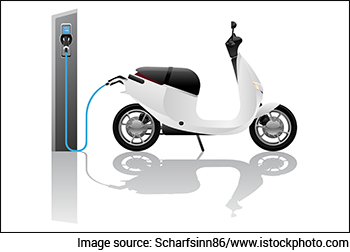India's Third Giant Leap
This Could be One of the Biggest Opportunities for Investors
This is What You Must Know Before Investing in EV Stocks

Is the Glass Half Full or Half Empty?
This famous analogy is used to compare positive and negative mind sets.
I agree, to do well in life and in the stock market, it's necessary to have the glass half full mind set.
However, I practice a third angle to this analogy.
The Opportunistic Mind Set
While people debate over the glass being half full or half empty, I quickly take the glass in my hand and drink the water before someone else does!
That's an opportunistic mentality which will help you make money in the stock market.
Opportunity in the stock market = Buying the Right company at the Right Time.
I like to focus on the right time i.e. grabbing an opportunity at the right time.
The important words here are Right Time.
In the markets, being early is equally harmful as being late. This is different from trying to time the market.
Let me talk about the perils of being ahead of the curve.
Don't be Ahead of the Curve
People living in Mumbai and Gujarat must have heard about Raj Travels. It's a famous luxury tour operator.
It's unique selling proposition was providing mouth-watering Indian food in its tours abroad.
It was the go to travel agency for Bombay's elite who, for a premium price, received crafted customised tours with a cook to feed them Indian food at places like the Eiffel Tower.
Founded by Mr Lalit Seth, Raj Travels during the early part of the 2,000s, gave tough competition to the likes of SOTC and Thomas Cook - pioneers in travel, especially international travel.
Raj travels tasted dizzying success with over 400 tour departures every year.
Just when the business was on auto pilot mode, cruising with steady revenue growth and limited debt, the owner got too ambitious... or should I say he was 'ahead of the curve'.
At a borrowed investment of Rs 1 bn, he sourced 104 customised bus coaches each costing Rs 8 m.
Along with the coaches, Raj Travels ushered in new concepts like waiting lounge and online bookings on a network of 200 routes pan-India.
The concept failed miserably. This lead to debts accumulating to Rs 1.5 bn by 2008.
The core tour operator business which was the cash cow too started seeing a slowdown as preferences for travelling changed.
Unlike the previous times, the cash flow from the core business couldn't offset the huge losses in the coach segment.
If you look at the coach business today, offering online booking is a necessity. The middle class consumer of 20 years ago wasn't looking for a posh waiting lounge.
His priority was to travel from point A to point B. There was no way he could pay for those overheads.
Those looking for luxury and could afford online booking. The elite and rich travelled by air.
This is a classic case of being ahead of the curve.
The Next Big Thing
Every day we are bombarded with themes and concepts which are touted to be the next big thing.
'Electric vehicles' or 'solar' or 'drones' are the talk of the town.
I completely agree these are nascent sunshine industries. EVs especially will be a huge wealth creator.
But not all segments in the electric vehicle space and not all companies in the renewable energy space will be successful.
If you are ahead of the curve, the opportunity cost will be massive.
For example, in the auto space, shift from petrol to electric is certain.
However the adaptability of segments is likely to wary. Electric 2-wheelers are likely to have a faster adoption rate based on factors such as ease of charging, payback period, and lower difference in costs.
Electric cars are likely to take longer on account of a higher difference in costs versus its petrol counterparts, difficulty in charging, and the limited number of models.
The price difference between a Tata NEXON EV and an equivalent petrol car, is nearly 50% in favour of the latter.
On the other hand, the price difference between an electric 2-wheeler and a Honda Activa 6G is barely 15-20%.
Heavy trucks and tippers are likely to be the last adopters of EVs.
In my view the pecking order of EV adaptability is as follows:
- Two wheelers
- Passenger 3 wheelers, state & city transport buses
- Passenger vehicles
- Commercial vehicles like trucks and tippers
Therefore, being underweight on traditional commercial vehicle companies and their ancillary companies, is being ahead of the curve.
Keep this is mind if you're thinking of investing in EV stocks.
What is your opinion, dear reader? Write to me with your views here.
Warm regards,
Aditya Vora
Research Analyst, Hidden Treasure
Recent Articles
- A Unique Smallcap Stock for Your AI Watchlist November 22, 2024
- AI is the future, whether or not you are ready for it. To avoid missing out, here is a stock for your watchlist.
- Why the Stock of Sanghvi Movers Should be on Your 2025 Watchlist November 21, 2024
- This smallcap stock is a good proxy play for the wind energy megatrend.
- Is Innovation Already Priced into Siemens India's PE Ratio of 100? November 20, 2024
- Siemens India's 100x PE an indicator of economic buoyancy or market froth?
- 20 Stocks to Watch in 2025 November 19, 2024
- Your guide for putting together a watchlist of stocks for 2025.


Equitymaster requests your view! Post a comment on "This is What You Must Know Before Investing in EV Stocks". Click here!
Comments are moderated by Equitymaster, in accordance with the Terms of Use, and may not appear
on this article until they have been reviewed and deemed appropriate for posting.
In the meantime, you may want to share this article with your friends!